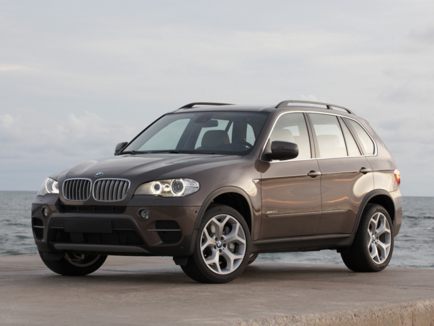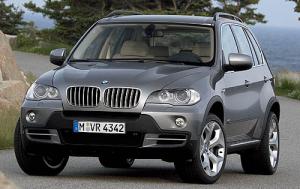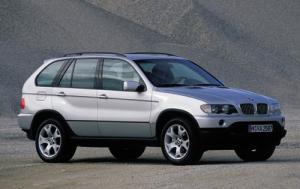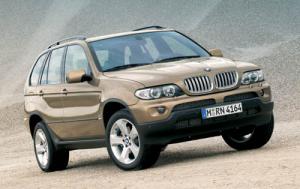In today's very high-priced used car market, many shoppers are now looking for "older" models that have aged well as a way to save significant dollars.

This really then puts the spotlight on a model's track record for reliability and dependability. And in terms of the BMW X5, it's a bit of a mixed picture.
While BMWs are known for their solid build quality and excellent driving performance, they are also highly-engineered, complicated vehicles that are prone to repairs.
In addition, the cost of both routine maintenance and repairs are higher than nonluxury brands. It can be kind of a double whammy.
On the other hand, many owners have reported very positive experiences with their X5s with only routine maintenance, with many lasting in the 200,000 - 300,000 mile range. So much of it comes down to "proper care", as well as a bit of luck.
So, here ...
- We'll do an overview of the first and second generation X5, produced from 2000 - 2013.
- We'll also list the possible mechanical issues that have been reported by owners of these older X5s so they can be checked before buying one today.
- And then we'll summarize the overall pros and cons of an older BMW X5 worth consideration by potential buyers.
But first, and very importantly ...
Things To Do When Considering An "Older" Vehicle
Locate Lower Mileage Vehicles: They are certainly out there to be found with careful and patient shopping. Be willing to drive a distance if you have to.
Vehicle History and Maintenance: Ask for the vehicle history report (CarFax or AutoCheck) as well as documented maintenance and repair records. If not provided by the Dealer or private seller, it's usually best to move on.
Pre-Purchase Inspection: Have the vehicle independently inspected before making a final decision. This usually will cost in the $150-$200 range but is well worth it given the potentially thousands in savings over the long term.
And My #1 Price Tip: Please, always get online price quotes at auto sites such as CarsDirect.com and Edmunds.com (both, actually), whether looking for a new or used car. Competition among dealers for your business does amazing things to prices, and it's so easy. It really does make a difference.
And quickly, while we're at it, my #2 Tip is to always know the up-to-date trade-in value of your current car. You can get a quick and surprisingly accurate one at Edmund's Trade-In Quotes.
It's free and just takes a couple of minutes. I think what helps its accuracy is the inputs will include either your plate# or VIN# followed by many simple, but specific, yes/no questions. It really focuses in on the detail of the specific vehicle.
Second Generation BMW X5 (2007 - 2013)

BMW had figured out that the vast majority of SUV owners really don't use their vehicles for off-road driving. So, in developing the X5, they designed it to clearly enhance the on-road driving experience.
The result is a luxury compact SUV with superb on-road performance and handling ... and a big hit with American drivers.
Redesigned for the 2007 model year, this version added 7.4 inches to accomodate a third row seat (it's small, however, too small for adults) and extra cargo room. Also added was a new double-wishbone front suspension to further smooth out the ride. And all were furnished with run-flat tires.
This generation X5 is powered by either a 260 horsepower incline six-cylinder engine (available on the X5 3.0si) or a 350 horsepower 4.8-liter V8 (available on the X5 4.8i) for those who want the added vroom.
Typical standard features on the six-cylinder include vinyl "leatherette" upholstery, 10-way power front seats, a panoramic sunroof, cruise control, 18-inch wheels, dual-zone climate control, driver memory settings, adaptive xenon headlights, traction and stability control, a rollover sensor, the iDrive electronics interface and a 12-speaker audio system with two subwoofers, a CD player and an auxiliary audio jack.
The V8 version is almost identically equipped but comes with leather upholstery.
Older models can also be found with all sorts of optional features, including the Premium Package which adds leather upholstery (in the 3.0si), Bluetooth, an auto-dimming rearview mirror and power lumbar support.
Those with the Sport Package have 19-inch wheels, a sport steering wheel, adjustable front seat thigh support, electronic dampening control and active roll stabilization, while the Technology Package added navigation, a rearview camera and front and rear parking assist.
Other optional features to be found include a power liftgate, a rear entertainment system, upgraded multi-contouring power front seats with ventilation, HD radio, satellite raio, an iPod adapter, a head-up display, a third-row seat and BMW's active steering system.
And the interior furnishings are actually outstanding. As you would expect from BMW, the materials are of excellent quality, all the luxury features are available and the craftmanship is superb.
For the 2009 model year, the models were renamed the X5 xDrive 30i, the X5 xDrive48i and the turbodiesel xDrive35d (xDrive refers to the standard all-wheel-drive system).
Car Buying Tips:
Learn to Negotiate Low Car Prices
Learn About Repossessed Cars For Sale
Do This For The Best Trade-In Price
The three engine choices consisted of a 260 horsepower inline six-cylinder on the X5 xDrive35i, a 350 horsepower 4.8-liter V8 on the X5 xDrive48i and a turbocharged diesel engine that delivers 265 horsepower and 425 pound-feet of torque on the X5 xDrive35d.
There were more substantial changes in 2011, including Premium and Sport Activity trims and new engines paired to a standard eight-speed transmission that was lighter and more powerful.
The base xDrive35i was powered by a 302-horsepower turbo six-cylinder, while the new xDrive50i came with a 400-horsepower twin-turbo V8. The diesel and M models were unchanged.
2007 - 2013 BMW X5 Possible Mechanical Problems
The 2nd generation X5, also known as the E70 model, has experienced some common mechanical issues reported by owners. It's important to note that individual experiences varied, and not all vehicles encountered these problems, but they should all be included in an inspection prior to buying.
Suspension Components: Owners have reported problems with various suspension components, including air springs and struts.
Leaking Oil: Some X5s from this generation experienced oil leaks, which could be attributed to issues with the valve cover gaskets or other engine seals.
Cooling System Problems: Failures in the cooling system, such as radiator leaks or issues with the water pump, have been reported.
Transmission Issues: Some owners reported transmission problems, including rough shifting, hesitation, or failure.
Electronic and Electrical Issues: As with many modern vehicles, BMWs are equipped with complex electronic systems. Owners have reported problems with features like the iDrive system, electronic modules, and sensors.
Brake System Concerns: Issues with the brake system, including premature wear of brake pads and rotors, have been mentioned by some owners.
Turbocharger Failures: For models equipped with turbocharged engines, there have been reports of turbocharger failures.
Air Suspension Problems: For X5 models equipped with air suspension, some owners have reported problems, including air leaks and compressor issues.
First Generation BMW X5 (2000 - 2006)

The X5 made its first generation debut for the 2000 model year and was powered by a 4.4-liter V8 engine that could move the X5 from a standstill to 60 mph in less than 8 seconds. These X5s have a five-passenger capacity.
The more significant changes used X5 buyers should be aware of during this generation include:
In 2001, a 3.0-liter inline six-cylinder engine was also made available to provide better fuel economy while still offering adequate overall performance.
It should also be noted to older BMW X5 buyers that all those manufactured after June 2000 (beginning with the 2001 model) also received structural changes that improved occupant protection in frontal crashes.
The 2002 model year saw the debut of the high-performance BMW X5 4.6is which was powered by a 4.6-liter V8 that pumped out 340 horsepower and 350 pound-feet of torque.
In addition, this year saw the midlevel X5 4.4i get an 8 horsepower boost as well as a new stability control system that enhanced trailer towing. It's also the year that a CD player became standard.
In 2004, the X5 was refreshed with a new front fascia, corona ringed headlamps, new foglamps and optional adaptive headlights were made available. BMW's new and more capable all-wheel-drive system, xDrive, was also introduced and could transfer a full 100% of engine torque to a single wheel.
Another significant change for 2004 was the dropping of the X5 4.6is in favor of the new high-performance 4.8is 355 horsepower model. In addition, BMW's 2002 7-Series V8 engine was used in the midlevel X5 4.4i for an increase to 325 horsepower.
2000 - 2006 BMW X5 Possible Mechanical Problems
The 1st generation X5, known as the E53 model, has also had its share of reported mechanical issues. Again, keep in mind that these problems are not universal, and many X5s from this generation have proven to be very reliable. However, reported mechanical issues that should be included in a pre-purchase inspection include:
Cooling System Problems: Similar to the second generation, the first generation X5 has had reported issues with the cooling system, including radiator leaks and problems with the water pump.
Oil Leaks: Oil leaks, often attributed to gasket failures, were reported by some owners. Common areas for leaks included the valve cover gaskets and oil pan gaskets.
Suspension Components: Some owners experienced problems with various suspension components, such as air springs, shocks, and control arms.
Transmission Issues: Some X5s from this generation have reported transmission problems, including issues with the automatic transmission. These could manifest as rough shifting or complete transmission failure.
Brake System Concerns: Problems with the brake system, including premature wear of brake pads and rotors, were reported by some owners.
Electrical and Electronics Issues: As with the second generation, electronic and electrical issues were reported. These could involve problems with the vehicle's electronic modules, sensors, or the optional navigation system.
Drive Shaft and Transfer Case Issues: Some owners reported problems with the drive shaft and transfer case.
Door Handle Carrier Failure: The door handle carriers, particularly on the rear doors, were reported to be prone to failure.
Overall Older BMW X5 Pros And Cons

Older BMW X5 Pros
Lower Purchase Price: Obviously, older BMW X5 models typically have a lower initial purchase price, allowing for upfront saving. However, this has to be weighed against the possibility of higher repair costs going forward.
Depreciation Slows Down: Older vehicles have already experienced the bulk of their depreciation. While they will continue to depreciate, the rate is generally slower compared to newer cars.
Classic Design: Some people appreciate the classic design and styling of older BMWs, which may have a timeless appeal.
Known Issues: Older models often have well-documented issues and common repairs, allowing for anticipating and budgeting for potential maintenance costs. This can also be an advantage when it comes to preventive maintenance.
DIY Maintenance: If you are mechanically inclined, older models may be more accessible for DIY maintenance and repairs, potentially saving on labor costs.
Sporty Handling: The X5 was praised for its sporty and car-like handling, setting it apart from many other SUVs in its time.
Powerful Engine Options: Older X5s offer a range of powerful engine choices, providing good performance and acceleration.
Luxurious Interior: In the early X5s, BMW maintained its reputation for luxurious interiors with quality materials and comfortable seating.
All-Wheel Drive System: The X5 came with BMW's xDrive all-wheel-drive system, enhancing traction and stability on various road conditions.
Safety Features: It featured a range of safety features and systems, which were advanced for its time.
Advanced Technology: BMW X5 models often come equipped with advanced technology features, including infotainment and driver assistance systems.
Spacious Cabin: The X5 is an SUV, and as such, it usually offers a spacious and comfortable cabin, with ample cargo space.
Older BMW X5 Cons
Higher Maintenance Costs: While the initial purchase price may be lower, older vehicles can come with higher maintenance and repair costs.
Potentially Higher Mileage: Older vehicles may have higher mileage, which can lead to more significant wear and tear on components. Regular maintenance becomes crucial in these cases.
Expensive Maintenance: In addition to the above, like many luxury vehicles, maintenance and repairs could be more costly than non-premium brands.
Outdated Technology: Older models may lack the latest technology features, safety advancements, and infotainment systems found in newer vehicles.
Fuel Efficiency: Depending on the engine choice, fuel efficiency might not have been as high as some competitors in the same class. Also, older models may have less fuel-efficient engines compared to more modern counterparts.
Complex Electronics: Some users have found the electronic systems, including the iDrive system, to be complicated and not as user-friendly as other systems.
Limited Third-Row Seating: The X5 was primarily designed as a five-seater, and the available third-row option is not spacious, limiting its practicality for larger families.
Limited Cargo Space: While being an SUV, the X5 might not have as much cargo space as some competitors in its class.
 By Josh Rosenberg
By Josh Rosenberg